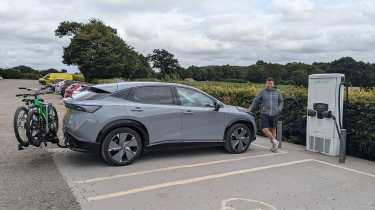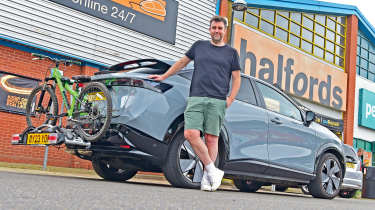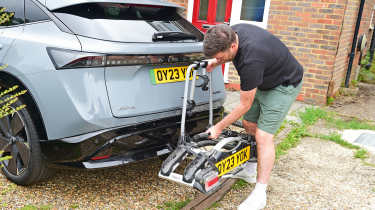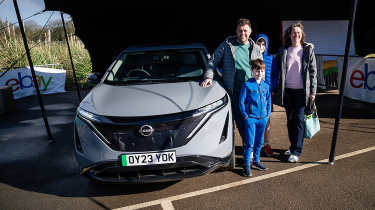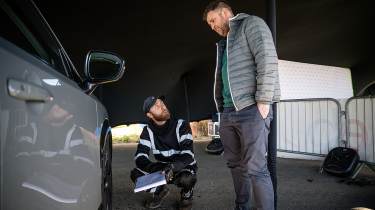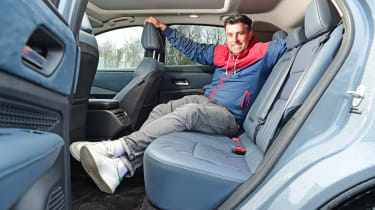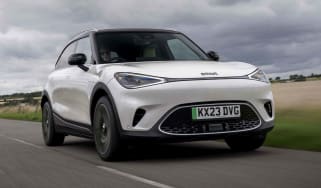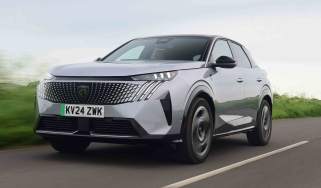Nissan Ariya e-4ORCE long-term test: plush family EV is under pressure from newer rivals
Final report: our time with the big Nissan EV was good, but not great
Verdict
The Nissan Ariya has been a pleasure to live with. Cabin comfort, passenger space, the relaxed driving experience and the potent powertrain all go in the plus column. The dated infotainment, mediocre boot and average efficiency tip the scales the other way.
- Mileage: 12,109
- Efficiency: 2.9 miles/kWh
The sun has set on our time with the Nissan Ariya. Two and a bit years ago we thought this electric SUV was the pick of the new-car crop and named it our 2022 Car of the Year, but what do we think of it today after 5,000 miles of long term testing? Let’s just say, it’s complicated.
Inevitably, Nissan’s offering is no longer the cutting-edge proposition it once was. It’s still a fine family car, however, and even for something costing £40,000 in base form and £54,840 as tested in top-spec Evolve trim with e-4ORCE all-wheel drive and the larger 87kWh battery, the Ariya feels classy.
What wow factor there is stems from the interior – the Ariya is not a car that turns heads, not in sober Ceramic Grey paint.
But open the driver’s door and it’s harder to quibble with the designers’ efforts, particularly with the blue suede trim and Nappa leather seats you get as part of the £1,995 Sport Pack, which also adds 20-inch alloy wheels. Despite initial doubts, the Alcantara finishes on the dash and doors proved resistant to sticky fingers and the seats were a joy to sit in. Details such as the full-width, deep-pile floor mats, the wood-effect dash and latticework design of the speaker covers all helped to justify what is quite a hefty sticker price on our car. Similar money gets you a dual-motor Tesla Model Y.
Used - available now

2024 Nissan
Ariya
13,221 milesAutomaticElectric
Cash £20,371
2024 Nissan
Ariya
21,645 milesAutomaticElectric
Cash £23,340
2024 Nissan
Ariya
1,254 milesAutomaticElectric
Cash £26,500
2024 Nissan
Ariya
38,375 milesAutomaticElectric
Cash £18,720The Ariya’s electric sliding centre console is a nice party-piece but it didn’t get a lot of use. Yet the excellent cross cabin access it helps to create is great when you need to unload the kids safely at the roadside. It was a similar story with the cubby that drops down from under the dash – a neat trick, but it worked too slowly for my limited patience.
Storage options are plentiful but Android users have to plug their phones in due to the lack of wireless connectivity. This renders the charging mat under the armrest useless, and means you end up with cables trailing about the place. Apple CarPlay is wireless.
In the back, the seat bases are a little low to the floor for the longer of limb, but legroom is plentiful even behind a six-foot driver. The boot isn’t huge, with the e-4ORCE 4x4 models getting 62 litres less than the front-drive ones due to the rear-mounted electric motor.
As well as the bigger boot, skipping the Ariya’s e-4ORCE all-wheel drive system when speccing the car presents you with a £2,700 saving that might just bring the Sport Pack option (with its swish interior and bigger wheels) into range. This is the route I’d take. You lose some power and performance, with the 0-62mph time extending from 5.7 seconds in the e-4ORCE car to 7.6 seconds, but you’ll get better efficiency, and the Ariya isn’t a car that invites you to use its clout, anyway.
Indeed, this car doesn’t feel anything like as enjoyable to drive as the feisty acceleration figures suggest. Although grip is plentiful and deploying the power is never an issue with the 4x4 system standing by, the Ariya’s weight is felt through the corners. Still, the overall driving set-up is hard to criticise too strongly given the family car remit.
Nissan Ariya e-4ORCE: third report
Family life demands a boost in our EV’s practicality
- Mileage: 10,210
- Efficiency: 2.9 miles/kWh
Practicality is the cornerstone of every family car, but even the most cleverly designed vehicles sometimes need a little help. So it was with our Nissan Ariya, which has benefited from a trip to Halfords, for a boost in its carrying capacity.
The all-wheel-drive Ariya e-Force has a removable towbar that you can specify on any Ariya for just under £1,000. The 1,500kg maximum braked trailer towing capacity is pretty good for an EV. It means you can pull a moderately sized caravan, although we only needed a towbar-mounted bike carrier.
The towing ball locks into place with a key and lives under the boot floor when not in use. It’s easy to attach, and because there’s very little space in the compartment for anything besides the puncture repair kit and components for the Bose stereo upgrade, carrying it there is no hardship.
If you want to carry bikes as well as luggage in your Ariya, Nissan sells a range of accessories, including roof racks, roof boxes and bike carriers, at reasonable prices – if you don’t fancy a trip to Halfords. Our model also has the rear-view mirror that can show a feed from the rear-facing camera if your view out of the back window is blocked.
The Ariya generally makes the most of its EV platform to boost its practicality. The flat floor gives great cross-cabin access, which is helped by the powered, sliding centre console. You can either move this forward to help those in the rear, or move it back and make it easier for those in the front to get out of the opposite door. We don’t move it back and forth regularly, but being able to set it in our preferred position is handy.
With the centre console in a forward position, the middle berth on the back seat is just about viable for an adult, but it’s not particularly comfortable for a long journey. Treat the Ariya as a four-seater and space is pretty good for a couple of six-foot adults. Anyone much taller than that is going to have leg and headroom issues, however, and the high floor does bunch your legs up so your thighs don’t rest on the seat base.
The ISOFIX points on the outer seats are some of the best we’ve encountered for easy access. They have their own little zippers that you open and poke the seat mounting points through. Inside these little zip-up pockets, the ISOFIX point itself is completely unobstructed, so you really can’t miss when you fit the seat. There are two USB sockets in the rear, but one is USB-A and one is USB-C, which has caused a few disagreements.
The rear bench splits 60:40 and folds almost flat. I like the little mouldings on the seat shoulders that hold the seatbelts in place, so you don’t trap them behind the seat when you return to passenger-carrying mode, but the Ariya isn’t exactly packed with convenience features. There’s no space under the boot floor for charge cables, so they go in cubbies to the side in the cloth bags provided. The boot is a fair 408 litres, but would be bigger were it not for the sloping rear window. The back seats don’t slide and there’s only a small door pocket or pockets in the front seat backs for storage in the rear.
Up front, the seats are very comfortable and storage is better, although the sliding centre console doesn’t offer a lot of space. Under the armrest is room for a phone on the charging pad and not much else. But there’s no USB socket there, so Android Auto users have to run a cable from the socket down at the front of the console. This looks a bit untidy, but at least it helps to stop you forgetting your phone when you get out.
The cubby that folds out from under the dash is roomier than it looks. It’s great for valuables as well, because it’s hidden and can’t be opened without the key.
Probably the best thing about the Ariya’s interior for me is its quality and design. I’ve really grown to like the blue leather and Alcantara trim in this Evolve model, and both are holding up well at just past 10,000 miles. The dashboard buttons that blend into the sweeping wood-effect dash panel, the plastic mesh for the speaker covers, and the lovely deep-pile floor mats are all classy and unusual touches that lift the tone inside.
Less impressive is the car’s touchscreen, which is a little low-res and slow to respond, compared with the best modern units. The information displayed on the driver’s screen can look cluttered, too, but the worst part is having to accept Nissan’s safety disclaimer every time you start the car before you can use the screen. Other manufacturers don’t require this and it seems excessive that Nissan perseveres with it.
Nissan Ariya e-4ORCE: second report
A very premature MoT check shows the Ariya is in good health after 9k miles, and there are few complaints from the Walker family
Our Nissan Ariya is still the best part of two years short of its first MoT test, but you can’t be too careful, especially not when eBay offers you a free pre-MoT check.
The global auction powerhouse set up a pop-up garage at Woburn Safari Park in Bedfordshire as part of a push to promote its car parts and accessories retail operation. The Ariya passed with flying colours, as you’d hope for a 13 month-old, 9,000-mile EV, and the Walker family got to see some monkeys.
There was one blot in the car’s copybook when the technicians reported “slight wear on the front brake discs”. EVs are generally supposed to be fairly light on their braking consumables, by virtue of the strong regenerative braking systems that mean you have to use the car’s actual brakes far less frequently, but it’s a potential issue that we’ll be keeping an eye on.
Service intervals for the Ariya under ‘normal driving conditions’ are every 12 months or 18,000 miles, with a full service every 24 months or 36,000 miles. That’s a little longer in terms of mileage than with a petrol or diesel car, and there’s less required to be done on each visit, with no engine oil or oil filters to worry about. Nissan sets the intervals for a diesel X-Trail SUV at 12 months or 9,000 miles, for example.
Back to those brakes, and I’ve been selecting the Nissan ePedal mode as a matter of course when driving in town. It performs largely as advertised, removing the need for those gentle brake inputs you have to make on a car without a strong brake-regen effect. It won’t bring the car to a complete stop for true ‘one-pedal driving’, but plan ahead in the right traffic conditions and you can still make brake use a rare event.
You’ll still probably want to disengage the ePedal mode for longer trips, because it slows the car too briskly when you release the throttle at higher speeds.
There’s also a ‘B’ mode on the main drive selector that offers a less intrusive setting somewhere between the standard brake-energy regen effect in ‘Drive’ mode and the ePedal, but if you’re going to choose one, why not go the whole hog with the ePedal? I do.
The other issue that’s developed on the car is a squeak from the front-wheel area on left-hand bends. It’s almost inaudible with the windows up – credit to the car’s robust soundproofing for that – but as the weather has warmed up and the windows have come down, I’ve started to notice its intermittent whine when just the right angle of left-hand steering lock is applied and the car’s weight moves to the front left corner. Otherwise, this 9,000-mile car seems to be in rude health.
We’re also starting to see the expected seasonal electric car range improvement. The car struggled to break 2.5 miles per kWh in the winter, for an indicated range on a full charge of around 210 miles. Now temperatures have climbed, it’s getting up to 3mi/kWh without much effort and better than that on longer runs. I’m typically seeing 230 to 240 miles indicated on a full charge with mainly urban driving, and 3.5mi/kWh is possible in Eco mode on longer A and B-road trips. The official maximum range of 314 miles still looks a long way off, though.
The Ariya drives well for a big SUV, on its fully independent suspension. The car feels well tied down at speed, with none of that disconcerting bounciness that you can get in less sophisticated 4x4s on undulating roads. In corners, there’s initial body roll but then the Nissan’s low centre of gravity steps in, stopping the lean becoming excessive. Everything feels nice and stable.
As you’d expect from a car with e-4ORCE all-wheel drive, there are no issues getting the 306bhp power output down to the road and with 600Nm maximum torque, there’s lot of acceleration when you need it. Sport mode quickens responses but adds a lot of weight to the steering and activates the annoying artificial ‘engine noise’ that sounds like it’s inspired by the flying-saucer effects in a fifties’ B-movie. I usually leave it alone.
At lower speeds the Ariya isolates its occupants from rough surfaces well. There is a tendency for slight shudders to go through the car when the rear end rides over bigger craters, but Nissan’s engineers have largely got the set-up right for family-carrying duties. The car holds up well against rivals in this area and I can’t see many prospective buyers having complaints with the way it behaves on the road. Those prioritising a fun drive might want to look elsewhere, but they may also need to rethink their expectations of a 2.2-tonne SUV.
There’s no doubt that the EV market has moved on significantly since the Ariya arrived, and there’s no sign of it slowing down. But the Nissan remains one of the top dogs in the large electric SUV class, and it’s plush enough in the Evolve spec we’re testing to draw buyers away from alternatives with more premium badges; priced at more than £57,000 with options, that’s just as well.
Nissan Ariya e-4ORCE: first report
2022 Car of the Year joins our fleet, but will it impress us as much now as it did then?
- Mileage: 8,036
- Efficiency: 3.1 miles/kWh
Remember 2022? It seems such a long time ago, and in the fast-paced world of the electric-car market, it really is. Back in the summer of 2022, the Nissan Ariya was crowned as the Auto Express Car of the Year. It stood out thanks to its high-quality cabin, comfort and refinement, not to mention the strong performance and 309-mile official range from its electric powertrain.
Fast forward to 2024 and the market for electric family SUVs has filled out massively. So does the Nissan Ariya still justify its two-year-old accolade in today’s market? A long-term test feels like the ideal way to find out.
The car you see here hails from the upper reaches of the Ariya range and, priced from £54,840, this dual-motor e-4ORCE Evolve version looks quite expensive on paper.
That Ceramic Grey paint job is another £745 on top of the list price, and our car has also got the £1,995 Sport Pack. This gives you 20-inch wheels and the Nappa leather interior trim of the range-topping Evolve+ models. It does not, however, extend to the power boost that bumps the Ariya Evolve+ up to 388bhp from the Evolve’s 301bhp, and drops the already-lively 5.7-second 0-62mph time by 0.6 seconds. You need more than £4,000 to upgrade from an Evolve to an Evolve+ and having tried both, we wouldn’t bother. The standard car is quick enough.
Still, even with just these two options, our Ariya is priced at £57,580. This puts it in the same ballpark as a mid-range Audi Q4 e-tron or a top-spec Volkswagen ID.4 GTX, but the newly arrived Renault Scenic could be a bigger challenger for our Nissan.
So how do key bits of the Ariya perform, two years after its award? The cabin still looks really smart, particularly in Evolve trim, with its bells and whistles.
The deep-pile floor mats that span the full width of the cabin are a minor highlight, but winter weather means we’ll soon find out how easy they are to clean. I also love the aforementioned blue Nappa leather trim, which is accompanied by soft blue suede-type material on the dash and door inserts.
It feels very sumptuous with all the natural (and natural-looking) materials inside, including the wood-effect panel that sweeps right across the dash and houses the unusual touch-sensitive heating and ventilation controls.
Between the seats is the Ariya’s party-piece sliding centre console that can be electrically moved forwards and backwards – but it doesn’t really seem to add a huge amount in terms of practicality.
The minor controls and systems are contained within the wide infotainment screen on the top of the dash. Its resolution isn’t as crisp as on the best screens from rivals, but it is one of the easier systems to use. Nissan’s design for the menus and, particularly, the instrument cluster can look a bit cluttered, but once you actually start using the Ariya, you realise that prioritising ease of access to information over flashy graphics really does pay off.
One immediate bugbear is that the obvious place to put your phone is on the wireless charging mat under the central armrest, but Android users need a wired connection to use Android Auto (Apple CarPlay is wireless). Because there’s no USB socket near that handy phone storage area, you have to trail a long cable or relocate your phone to stick out of the slot at the front of the centre console next to the USB point.
Our Ariya has just over 8,000 miles on the clock, most of them potentially fairly hard work on the Nissan UK press fleet. Even so, as you’d hope, it’s holding up very well in terms of the materials and the way it drives.
Our Ariya might have 301bhp and a sub-six-second 0-62mph time but, as is so often the case with electric cars, such eye-opening numbers don’t translate to a heart-fluttering driving experience. However, although the suspension is sometimes noisy, it takes the edge off the bumps very well and, after the initial lean as you turn into corners, it keeps the body relatively well controlled.
Efficiency hasn’t been quite so impressive so far, though. The cold January weather has resulted in it returning a little over 3.0 miles per kWh, with the indicated range on a full charge hovering around 210 miles.
The caveat is that my motoring life tends to involve lots of very short trips around town combined with regular journeys on the motorway. During those longer A- and B-road trips, where the car is cruising more gently between stops for traffic lights and roundabouts, the efficiency numbers tend to improve towards 3.5mi/kWh. We’ll see how that develops as the test continues.
| Model: | Nissan Ariya e-4ORCE Evolve |
| Rating: | 3.5 stars |
| On fleet since: | January 2024 |
| Price new: | £54,840 (£57,980) |
| Powertrain: | 2x e-motors, 87kWh battery, single-speed auto, 4WD |
| CO2/tax: | 0g/km/0% |
| Options: | Sport Pack (20-inch wheels, Nappa leather upholstery, £1,995), Ceramic Grey paint (£745) |
| Insurance*: | Group: 42/Quote: £1,387 |
| Mileage: | 12,109 |
| Efficiency: | 2.9 miles/kWh |
| Any problems? | None so far |
*Insurance quote from AA (0800 107 0680) for a 42-year-old in Banbury, Oxon, with three points.


